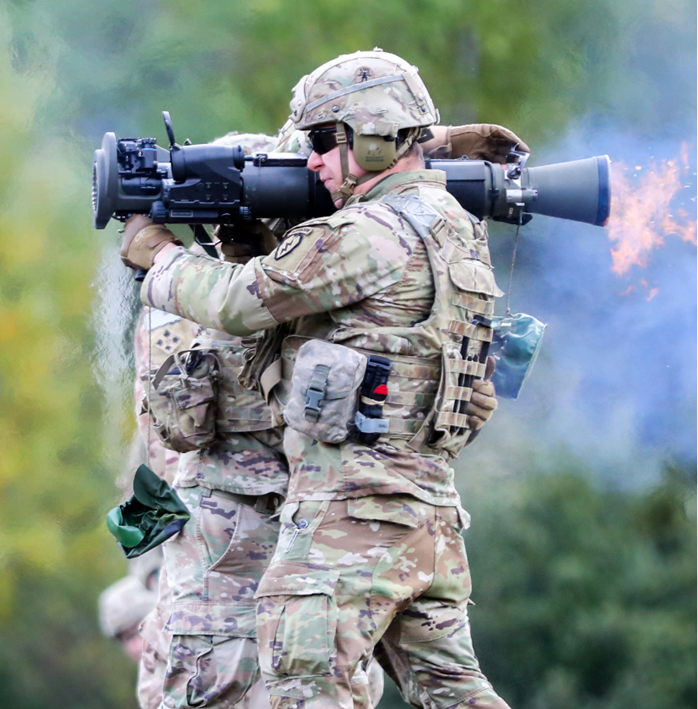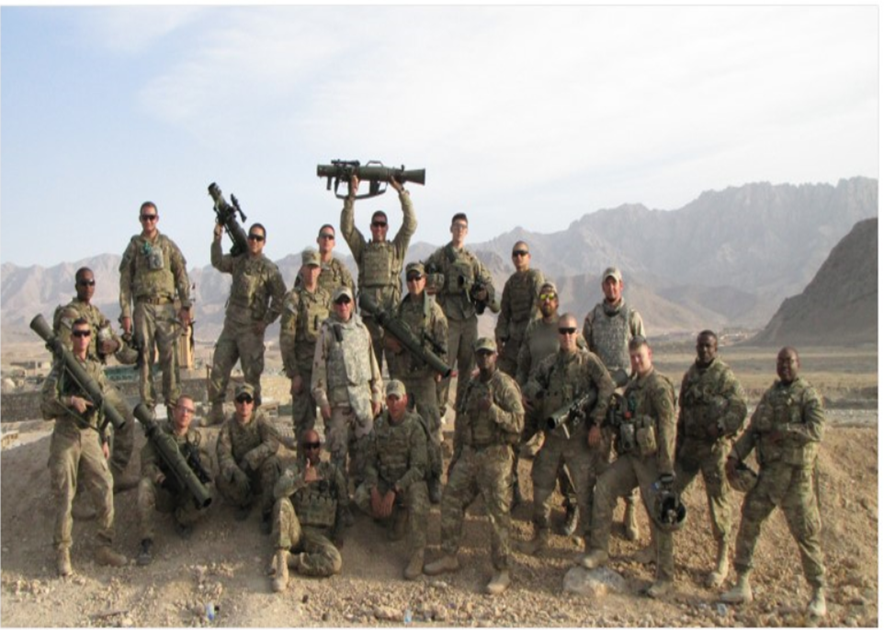
A TRAINED ARMY: Spc. Griffin Wisehart, an infantryman assigned to Company B, 1st Battalion, 168th Infantry Regiment, 2nd Infantry Brigade Combat Team, 34th Infantry Division, loads a round into an M3A1 Carl Gustaf Multi-purpose Anti-armor Anti-personnel Weapon System (MAAWS) during training at Camp Guernsey Joint Training Center in Wyoming on May 20, 2023. (Photo by Staff Sgt. Tawny Kruse, Joint Force Headquarters – Iowa National Guard)
How two organizations attained synergy to achieve success in separate but associated acquisition programs.
by Frederick Willecke, Dan O’Leary and Shelly Lowery
As each program executive office (PEO) and its associated project manager offices focus on their prescribed mission, there is a potential for stove piping and limited collaboration which generate development risk for equipment or systems that require interoperability or integration. Transparency and collaboration across organizations help minimize challenges by synergizing resources, cross-functional expertise, management and schedules. It is crucial that weapons and the ammunition that they fire, each developed and managed by separate organizations, function together as a complete system.
The development of the 84 mm M3A1 Carl-Gustaf Recoilless Rifle, and its associated 84 mm High Explosive (HE) 441E Reduced Sensitivity (RS) round, is an example of overcoming those challenges through sound decision-making, advance planning that leveraged an established memorandum of agreement between PEOs, and an esprit de corps generated by a cross-organizational, integrated product team.
PEO Soldier’s mission is to rapidly deliver agile and adaptive leading-edge Soldier capabilities in order to provide combat overmatch. Project Manager Soldier Lethality (PM SL), within PEO Soldier, is responsible for the development, production and fielding of small arms individual weapons, crew-served weapons, remote weapon stations and the associated fire-control systems, including the 84 mm Carl-Gustaf Recoilless Rifle.
The mission of the Joint Program Executive Office for Armaments and Ammunition (JPEO A&A) is to develop, procure and field lethal armaments and ammunition providing joint warfighters and allied partners overmatch capabilities. Project Manager Close Combat Systems (PM CCS), within JPEO A&A, is responsible for the development, production, fielding and life cycle management of lethal close combat munitions that ensure increased mobility and counter mobility to the full spectrum of Army forces, which includes the 84 mm HE 441E round.
To summarize, project manager offices in different PEOs are tasked to develop and produce two interdependent items (weapon and ammunition) in order to deliver the required operational capability. To successfully deliver capability to the warfighter these project managers must ensure program priorities are synchronized.

ON WATER: A Multi-purpose Anti-armor Anti-personnel Weapon System (MAAWS) High Explosive 441D fragment on water by Saab Dynamics AB, Sweden. (Photo provided by Saab)
THE SOLUTION
The success of the M3A1 Carl-Gustaf Recoilless Rifle and its associated 84 mm HE 441E round began with the development of their predecessors: the M3 Carl-Gustaf and the 84 mm HE 441D round. The M3, M3A1, and both 84 mm rounds fall under the Multi-Purpose Anti-armor Anti-personnel Weapon System (MAAWS), which is a reloadable shoulder-fired recoilless rifle capable of firing various munitions to achieve different target effects based on mission requirements. The M3A1 improves upon the M3 capabilities by significantly reducing the overall system weight and adding an advanced fire control system.
PEO Soldier and JPEO A&A signed a memorandum of agreement on Dec. 6, 2016, to support the M3 Carl-Gustaf and the 84 mm HE 441D round effort. This memorandum codified the plan and defined authorities, roles and responsibilities for conducting ammunition and other interdependent program research, development, test and evaluation and production activities associated with ammunition and weapon systems such as the MAAWS. During development, the team identified that the 84 mm HE 441E round required development of enablers to the M3A1 Carl-Gustaf’s advanced fire control and weapon electrical communication system. These enablers are required to obtain the target range, determine the ballistic solution, program the fuze, and set the airburst function upon firing.
Adding the enablers provided a significant increase in lethality and accuracy and reduced the engagement time as compared with the predecessor round and weapon. When this was identified, PM SL utilized the memorandum of agreement and formally initiated a development project that required aligning the appropriate funding requests with the respective PEOs within the DOD budgetary process. This effort also tied the two programs together with respect to schedule. This approach identified one singular project manager (PM SL) as the lead to manage the development activities and PM CCS to take over ammunition production and life cycle management after achieving type classification standard. This enabled PM SL to work closely with the original equipment manufacturers (Saab Dynamics for the weapon and ammunition, and Aimpoint for the fire control) and ensured unified direction to the vendors.
Additionally, PM SL established a teaming relationship among the manufacturers and U.S. Army Test and Evaluation Command in order to perform a combination of contractor-led testing and government-led testing. This collaboration was essential to streamline test activities to ensure both items met Army operational requirements. Furthermore, per the memorandum, PM SL ensured the right experts were involved in all aspects of development by funding an integrated product team that included an embedded PM CCS product support expert as well as shoulder-launched munitions engineers from the U.S. Army Combat Capabilities Development Command Armaments Center (DEVCOM AC). These experts have significant experience working on ammunition items and were essential for planning, review and analysis of the munition development.
While the PM CCS product support expert ensured all the necessary sustainment planning, coordination and documentation for the 84 mm HE 441E round was being executed through development, the DEVCOM AC munitions engineers coordinated all aspects of technology management with PM CCS to enable smooth transition to production. The PM CCS product support expert and the munitions engineers eventually moved to the integrated product team, funded and managed by PM CCS, once transition to production was complete. This transition was critical to support PM CCS responsibilities for production and execution of sustainment.

READY, FIRE: Multi-purpose Anti-armor Anti-personnel Weapon System (MAAWS) M3A1 fires during new equipment training. (Photo courtesy of PEO Soldier)
THE BENEFIT
This collaborative and integrated approach minimized the risk of rework, schedule slip and cost growth due to lack of synergy between the two project managers. PM CCS and PM SL have successfully managed the M3A1 and 84 mm HE 441E integration and qualification and ultimately achieved type classification standard on Jan. 3, 2023. As stipulated in the memorandum of agreement, the primary office of responsibility transferred from PEO Soldier to JPEO A&A (PM CCS) on Jan. 30, 2023, after PEO Soldier achieved the type classification standard milestone. Shortly after, PM CCS awarded a standalone delivery order to procure more than 3,000 munitions from Saab Dynamics. By leveraging the established memorandum and directly embedding DEVCOM AC experts with munition experience, all the experts became members of one team. This generated a feeling of pride, fellowship and a general spirit of collaboration. Ultimately, the team was able to have all programmatic documents approved on schedule, achieving type classification, a major program milestone and place the program on a path to successfully deliver necessary capability to the operational environment.

BAND OF BROTHERS: “Band of Brothers” Army Ranger Regiment in Afghanistan with a Multi-purpose Anti-armor Anti-personnel Weapon System (MAAWS) M3. (Photo by U.S. Army)
CONCLUSION
The structure of the chartered missions of the PEOs and project management offices within Army acquisition could present challenges when developing individual items that are reliant on one another to operate. By planning, identifying items that require synchronization across PEOs, leveraging formal documents like the memorandum of agreement, aligning funding streams and schedules, and joining experts from both organizations into one cross-functional integrated product team, both organizations were able to attain a synergy that resulted in the successful execution of two separate but associated acquisition programs.
For more information, go to https://jpeoaa.army.mil/Project-Offices/PM-CCS.
FRED WILLECKE is chief of product support at Project Manager Close Combat Systems (PM CCS) since August 2018. He holds a Master of Engineering – Systems Engineering and master’s certificates in systems supportability engineering and systems engineering and architecting from Stevens Institute of Technology; and has a B.A. in political science from Villanova University. He is Green Belt certified in Six Sigma and is DAWIA certified Advanced in life cycle logistics and a Practitioner in test and evaluation.
DAN O’LEARY is product support manager at Project Manager Close Combat Systems within JPEO A&A. He received his B.S. in liberal arts, administration/management studies from Excelsior College and is a graduate of the U.S. Army Sergeant Major Academy. He is Green Belt certified in Six Sigma and is DAWIA certified Advanced in life cycle logistics and Practitioner in program management.
SHELLEY LOWERY is a DECVOM AC product support integrator working with Product Manager Soldier Lethality within PEO Soldier and Project Manager Close Combat Systems within JPEO A&A. She holds an MBA in project management and a Bachelor of Business, both from Saint Leo University. She is DAWIA certified Advanced in life cycle logistics.
CONTRIBUTORS: AZAMAT Z. VILLAR, modernization lead at JPEO A&A; DAVID OKKEN, MAAWS team lead in Product Director Crew Served Weapons in Project Manager Soldier Lethality with PEO Soldier.







